Introduction
One of the main problems encountered in the formation of stands aiming at forest restoration is the quality of seedlings (Smiderle et al., 2021a). These, together with environmental factors and silvicultural techniques, are important for reducing costs and decreasing the time of settlement formation (Herrero et al., 2019).
Among the species with outstanding importance on the national scene, Agonandra brasiliensis Miers ex Benth. & Hook. F., belonging to the Opiliaceae family, popularly known as “pau marfim” (ivory wood), “cerveja de pobre” and “quina de veado”, has a wide geographical distribution in the state of Roraima (Smiderle et al., 2021b). However, there is little research involving Agonandra brasiliensis, mainly in relation to seedling production (Souza et al., 2020a), nursery management and forest restoration of dry land, cerrado and savanna ecosystems in the state of Roraima (Tonini & Lopes, 2006, p. 25).
Despite advances in the production of seedlings for native species in northern Brazil, there are still great gaps in knowledge about the propagation of native herbaceous species under nursery conditions (Smiderle et al., 2020), in order to produce seedlings for restoration and forest plantations (Nascimento et al., 2019).
For the establishment of forest plantations, whether for commercial purposes or restoration, several factors affect the formation of seedlings: the quality of seeds, volume of the container, substrate used, fertilization, and handling during the production process (Souza et al., 2020b).
The ideal substrate is one that presents uniformity in its composition, low density, good field capacity, cation exchange, water retention, porosity, but also adequate aeration and drainage, being free from pests and pathogens (Seedo et al., 2018). Often, the substrate, despite containing nutrients, does not provide enough quantity for the good development of the plants, requiring the addition of fertilizers in order to adapt it to the demands of the seedlings (Chanan et al., 2019). Among the fertilizers, there are those of controlled release, which have been widely used in nurseries of native forest seedlings.
Controlled release fertilizers are capable of providing and maintaining constant levels of macro and micronutrients in different formulations (Hanifah et al., 2019), over a period that can vary from three to 18 months, and this depends on the thickness of the fertilizer cover resin (Campos et al., 2019). These characteristics are favorable for the production of seedlings, since there is the availability of nutrients throughout the production process, meeting the demands of the plants and avoiding leaching of nutrients in case of excessive irrigation of the substrate (Ferrari et al., 2016).
However, the use of this type of fertilizer generates higher costs for seedling producers, requiring adjustments of doses and formulations for each species to be produced, reducing losses and maximizing investments in seedling production (Niemiec & Komorowska, 2018).
The improvement of techniques in the production of native seedlings in the state of Roraima, despite its importance in the national and international scenario, is still a small number of studies involving Agonandra brasiliensis, mainly with regard to the establishment of forest plantations, whether for commercial or restoration purposes.
Therefore, this study aimed to investigate different substrate compositions with and without the addition of encapsulated controlled release fertilizer (CRF) and to determine the correlations between morphological characteristics of ivory wood seedlings (Agonandra brasiliensis), in nursery conditions, in the State of Roraima.
Materials and Methods
The work was conducted in the Seed Analysis Laboratory and in the seedling nursery of Embrapa Roraima’s forestry. The species used in the present research was Agonandra brasiliensis Miers ex Benth. & Hook. The seeds used in the study came from Agonandra brasiliensis fruits collected from trees in the Serra de Nova Olinda, municipality of Boa Vista (RR), in March 2018 (coordinates 2° 56’ 58.99” N, 60° 44’ 48.30” w).
After the collection of fruits, the beneficiation proceeded (pulping and washing of the seeds), and then the seeds were sown, in a bed, which contained sand of medium size washed as substrate for the emergence and initial development of the seedlings. The substrate humidity was maintained with automatic irrigation, with four daily waterings.
Seedlings emerged approximately 50 days after sowing and, as soon as they reached an approximate height of 12.0 cm, they were transplanted into polyethylene bags (12 x 35 cm), containing different combinations of soil substrate, carbonized rice husk and medium sand, according to each pre- determined treatment, in which the controlled release encapsulated fertilizer (Forth Cote®) was incorporated in the formulation NPK 18-05-09, according to each treatment.
The experimental design adopted was completely randomized in a 2x5 factorial scheme, with the addition and without the addition of 1.0 g L-1 encapsulated controlled-release fertilizer, contains macronutrients which are coated in a membrane to allow for slow delivery over three to four months, and a guaranteed content of 18 % total nitrogen (N), 05 % phosphorus (P2O5) and 09 % potassium (K2O) and five substrates (T1 = Sub1 100 % medium-sized sand; T2 = Sub2 66 % soil + 33 % medium-sized sand; T3 = Sub3 50 % medium-sized sand + 50 % organic substrate; T4 = Sub4 75 % soil + 25 % carbonized rice husk; T5 = Sub5 75 % soil + 25 % organic substrate), with five repetitions, each repetition consisting of three seedlings (one in each container).
To measure the necessary volumes of the components to be mixed to compose the substrate, a graduated cylinder with a capacity of 1.000.0 mL was used. After homogenization, samples from each treatment were separated, for further chemical and physical analysis.
For the chemical analysis of the substrates, the Embrapa method (2009) was used to determine the available levels of macronutrients, pH, exchangeable aluminum (Al), titratable acidity (H + Al), cation exchange capacity at pH 7 (CTC) of the substrates. At 240 days, soil analysis was performed again to verify the increase in substrate fertility from the superficial incorporation of 1.0 g L-1 of encapsulated controlled release fertilizer, in the formulation NPK 18-05-09.
The plants were accommodated in a screened nursery with 50 % shade and maintained with sprinkler irrigation three times a day for periods of five minutes. The morphological parameters of the seedlings and their relations used in the evaluations were the increase in height and collet diameter. The data were obtained from collections carried out every 30 days (month) since the transplant, following the period of growth of the plants until the end of the experiment (240 days after transplanting DAT).
The evaluated variables were: Shoot height (H, cm) and shoot height increase (IncH, cm) were measured with the aid of a graduated ruler, and the collet diameter (CD, mm) and increment of the collet diameter (IncCD, mm) with digital caliper. The shoot dry matter (SDW, g plant-1), root dry matter (RDW, g plant-1), total dry weight (TDW, g plant-1), the relation between the shoot height and the collet diameter (H/CD), were obtained from oven-dried material, set at 65 °C, for 72 hours.
The total dry weight (TDW, g) is the sum of SDW and RDW and the ratio between shoot and roots dry weight (SDW/RDW). The total dry weight (TDW, g plant- 1) is the sum of SDW and RDW and the relation between the shoot dry weight and the roots (SDW/RDW). The Dickson quality index (DQI) was determined as a function of shoot length (H), and the collet diameter (SD), shoot dry weight (SDW) and root dry weight (RDW), through the formula (Dickson et al., 1960).
All results obtained were tested for homogeneity (Bartlett) and normality (Shapiro-Wilk) and, subsequently, the means were subjected to analysis of variance, followed by the Tukey test (p < 0.05) for comparison of means. Pearson’s correlation between phytotechnical variables and statistical analyses was performed using R software (2014).
Results and Discussion
The results of the present study showed an improvement in the chemical properties of the substrate, due to the addition of CRF to 240 DAT in the composition (Table 1), with a significant increase in the amount of nitrogen, phosphorus, and potassium, due to the CRF formulation NPK 18-05-09 added to each treatment.
Table 1 Chemical characteristics of the substrates formulated for the production of Agonandra brasílíensís seedlings

CV: coefficient of variation. Averages followed by the same letter, in the column, do not differ statistically from each other, by the Tukey test (p > 0.05);
*Significant (p < 0.05). Sub 1 = 100 % medium-sized sand; Sub 2 = 66 % soil + 33 % sand; Sub 3 = 50 % sand + 50 % organic substrate; Sub 4 = 75 % soil + 25 % carbonized rice husk; Sub 5 = 75 % soil + 25 % organic substrate.
The addition of macronutrients from the superficial incorporation of 1.0 g L-1 of encapsulated controlled- release fertilizer, in the formulation NPK 18-05-09, improved the availability of nutrients throughout the plant growth period on substrates with low cation exchange capacity (CEC), ensuring the maintenance of the substrate fertility.
The substrates 2, 3, and 4 did not show a pH value within the range considered adequate for the development of seedlings (from 5.5 to 6.5), according to the classification described by Smiderle et al. (2021a). The other tested substrates showed pH values adequate to those considered satisfactory. The pH value is an extremely important chemical characteristic because it is directly related to the availability of nutrients to plants, therefore, inadequate values can affect the development of plants, especially on substrates with a pH below 5 (Ünlükara, 2019), which was evidenced in sub 3 with pH 4.9.
Table 2 shows the result of the analysis of variance of the morphological characteristics of Agonandra brasiliensis on different substrates with the application of NPK 18-05-09. The interaction between the factors analysed was not significant, being significant only for simple factors.
Table 2 Analysis of variance for contrasts between substrate and addition of CRF factors for plant variables of Agonandra brasiliensis, 240 days after transplanting
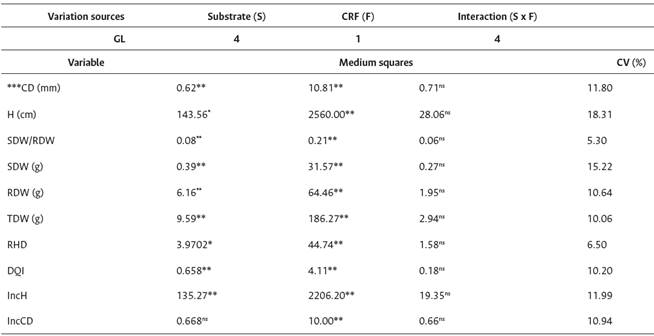
***Collet diameter (CD), shoot height (H), shoot and root ratio (SDW/RDW), shoot dry weight (SDW), root dry weight (RDW), total dry weight (TDW), relation between the shoot height and the collet diameter (RHD), Dickson quality index (DQI), Increase in height (IncH), Increase in Collet diameter (IncCD).
**Significant at the level of probability (p < 0.01); * Significant at the probability level (p < 0.05) and ns Not significant by the F test.
At 240 days, the substrates (Sub 1) 75 % soil + 25 % carbonized rice husk (Sub 4) and 75 % soil + 25 % organic substrate (Sub 5), with addition of CRF, they provided the highest averages in height of the Agonandra brasiliensis seedlings, reaching 35.8 cm and 46.3 cm, respectively (Figure 1A). In the substrate (Sub 5), without addition of CRF, Agonandra brasiliensis seedlings presented 46.5 % less height in relation to cultivation in the same substrates (Sub 5) that received addition of CRF (Figures 1A and 1B), justifying the importance of applying CRF for the production of Agonandra brasiliensis.
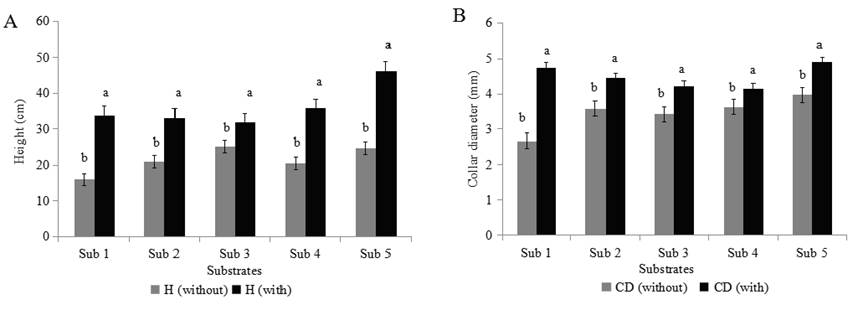
Figure 1 Combinations of substrates with and without the addition of encapsulated controlled-release fertilizer of Agonandra brasiliensis seedlings, at 240 DAT.
In the production of quality seedlings, it is important that the plant has a rapid growth, both in height and in the collet diameter, as the latter variable is decisive for the forest seedlings to be able to field. According to Menegatti et al. (2019), it must be between 4.0 and 10 mm, at least. In this sense, the average collet diameter of Agonandra brasiliensis seedlings varied between 4.99 and 2.70 mm, with and without the addition of CRF, respectively, in the different substrates (Figure 1B).
Similar to the results obtained for height, the lowest average of the collet diameter was observed in the plants produced without addition of CRF (Figures 1A and 1B). The results obtained in the present study confirmed that the addition of CRF contributed to the growth of the shoot of the seedlings.
For H/CD and SDW/RDW ratios, Agonandra brasiliensis seedlings showed differences between substrates with and without the addition of CRF evaluated (Figure 2A and 2B). Sub 4 and Sub 5 treatments with addition of CRF obtained a higher average (8.1) in relation to the others and within the limit considered ideal by Avrella et al. (2019) (8.1-9.4), indicating uniform plant growth, according to the author. This value was not achieved by the other treatments.
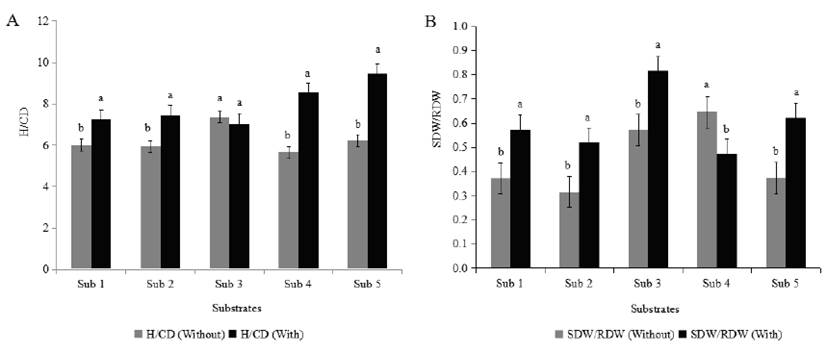
Figure 2 Combinations of substrates with and without the addition of encapsulated controlled-release fertiLizer of Agonandra brasiliensis, in nursery conditions at 240 DAT.
The Sub 4 and Sub 5 treatments showed the largest increments both in height and in the collet diameter (Figures 3A and 3B). It appears that higher M.O. were obtained from the substrates of the Sub 4 and Sub 5 treatments (Table 1), the same that promoted more accelerated growth of the plants, and that contains in its composition carbonized rice husk and organic substrate (Sub 4).
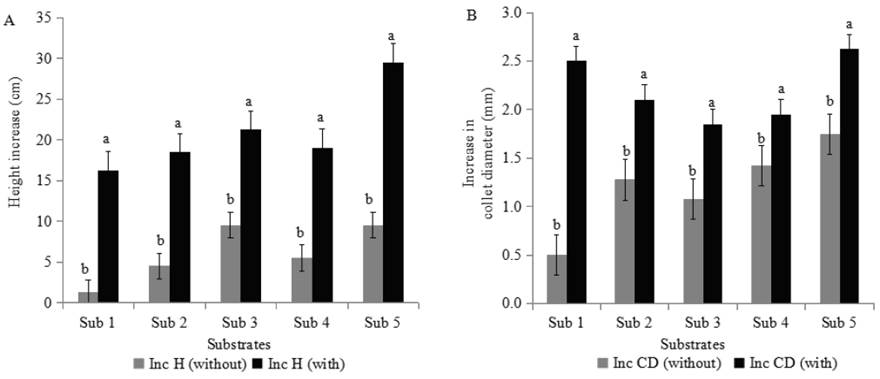
Figure 3 Combinations substrate with and without the addition of controlled-release encapsulated fertilizer of Agonandra brasiliensis plants, at 240 DAT.
The superiority in RDW production expressed by plants in Sub 1 and Sub 2 substrates, followed by Sub 5 with addition of CRF (Figures 4A and 4B), promoted the production and maintenance of larger root systems or roots in greater numbers, which allowed the exploration of a larger area of the soil by the root system and, consequently, greater efficiency of nutrient absorption. The efficiency in root absorption tends to guarantee the necessary supply of nutrients for the shoot, a fact evidenced by the higher production of SDW and TDW for the Agonandra brasiliensis seedlings.
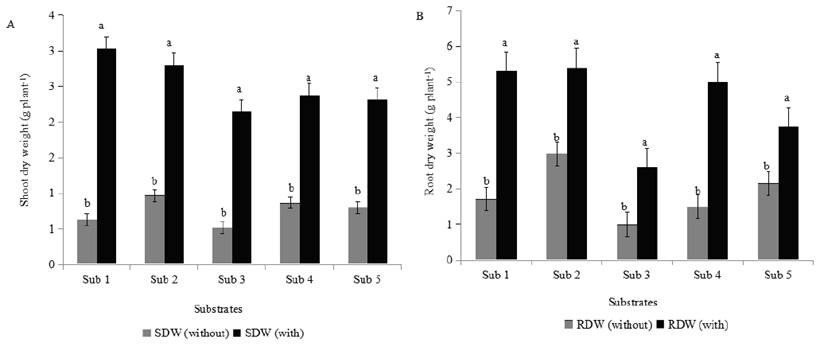
Figure 4 Substrate combinations, with and without the addition of encapsulated controlled release fertilizer of Agonandra brasiliensis plants, at 240 DAT.
The total dry weight (TDW) comprises the sum of SDW and RDW, and the higher this value, the better the quality of the seedlings produced (Silitonga et al., 2018). According to Rocha et al. (2019), the total dry weight indicates the rusticity of a seedling, with the highest values representing more lignified and rusted seedlings, and possibly exhibiting a higher survival rate in field conditions soon after planting.
There was a positive influence on the production of biomass by incorporating CRF in the Sub 1 (8.3 g plant-1), Sub 2 (8.2 g plant-1), and Sub 4 (7.3 g plant-1) substrates, presenting an increase of 72.2 %, 52.4 %, and 68.5 % respectively, when compared to Sub 1 (2.3 g plant-1), Sub 2 (3.9 g plant-1), and Sub 3 (2.3 g plant-1) without adding CRF (Figure 5A).
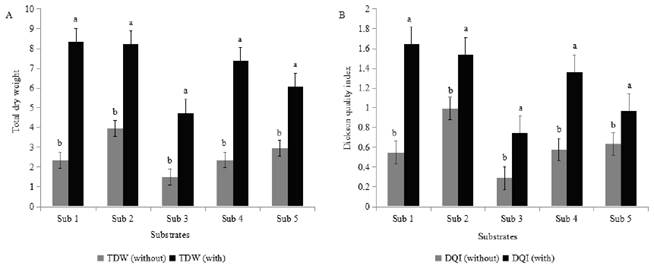
Figure 5 Combinations of substrates, with and without the addition of encapsulated controlled release fertilizer of Agonandra brasiliensis seedlings, at 240 DAT.
Regarding the biomass production evaluated from the quantification of the total dry weight (Figure 5 A), the results allowed to infer again the positive influence of the incorporation of CRF in the Sub 1 (8.3 g plant-1), Sub 2 (8.2 g plant-1), and Sub 4 (7.3 g plant-1) substrates, presenting an increase of 72.2 %, 52.4 %, and 68.5 % respectively, when compared to Sub 1 (2.3 g plant-1), Sub 2 (3.9 g plant-1), and Sub 3 (2.3 g plant-1) without adding CRF.
Plants produced on Sub 3 substrate with and without addition of CRF exhibited limitations for all morphological variables in the present study. The unsatisfactory performance of Sub 3 substrate 50 % organic substrate + 50 % sand is attributed to the pH of the substrate, below 6. According to Epstein and Bloom (2006), p. 403, soils with a pH below 6 (six) tend to reduce the availability of some nutrients, compromising the absorption and supply of the required amount of each element for the maximization of some physiological processes that culminate in growth.
The positive results of the use of alternative components in the production of Agonandra brasiliensis can be observed when analyzing the Dickson quality index. This index is a good parameter to indicate the quality of seedlings, because robustness (H/CD ratio) and balance of biomass distribution (SDW/RDW ratio) are in the calculation, weighting the results of several important morphological characteristics used for quality assessment (Massad et al., 2019).
For this index, Sub 1 and Sub 4 substrates with application of CRF showed seedling DQI twice as high, when compared with the same substrates without application of CRF (Figure 5B). In turn, the Sub 3 treatment, without addition of CRF, presented a DQI of 0.28, whose value is below the minimum limit (0.30) recommended by Lima et al. (2019).
Positive and significant correlations were found between most of the variables studied (Table 3). It can be seen in Table 3 that the variable (H) presented a positive and strong correlation (0.91) when related to the collet diameter of Agonandra brasiliensis seedlings. For Souza et al. (2016), the correlation between height and diameter demonstrates the growth balance between height and diameter of the seedling collection.
Table 3 Pearson's correlation coefficient matrix

Phytotechnical variables: Shoot length (H), collet diameter (CD), ratio of shoot length (H)/collet diameter, increment in shoot length (IncH) and collet diameter (IncCD), shoot dry weight (SDW), root dry weight (RDW) and the total dry weight (TDW), and Dickson quality index (DQI), between phytotechnical variables, under different combinations of substrates with and without the addition of encapsulated controlled release fertilizer from Agonandra brasiliensis plants.
The correlation between TDW and DQI at 240 days after transplantation was 0.94 considered as strong. According to Santos (2010), P. 264, the correlation is considered to be strong when it presents a coefficient of variation of 0.8 < p < 1. A positive and weak correlation was observed between CD and H/CD (0.47), the correlation is considered weak when it presents a coefficient of variation of 0.1 < p < 0.5 (Santos, 2010, P. 264).
Considering the results obtained in this study, it is suggested that with the use of CRF incorporated into the substrate, it is possible to obtain Agonandra brasiliensis plants with high quality standards.
Conclusions
The substrates composed of 75 % soil + 25 % organic substrate and 100 % medium sand with the addition of Forth Cote® are indicated for the production of Agonandra brasiliensis seedlings.
The substrates 100 % medium sand and 66 % soil + 33 % medium sand are indicated for greater growth of root system of seedlings Agonandra brasiliensis.
Agonandra brasiliensis seedlings have a positive and high correlation with the studied morphological characteristics.














